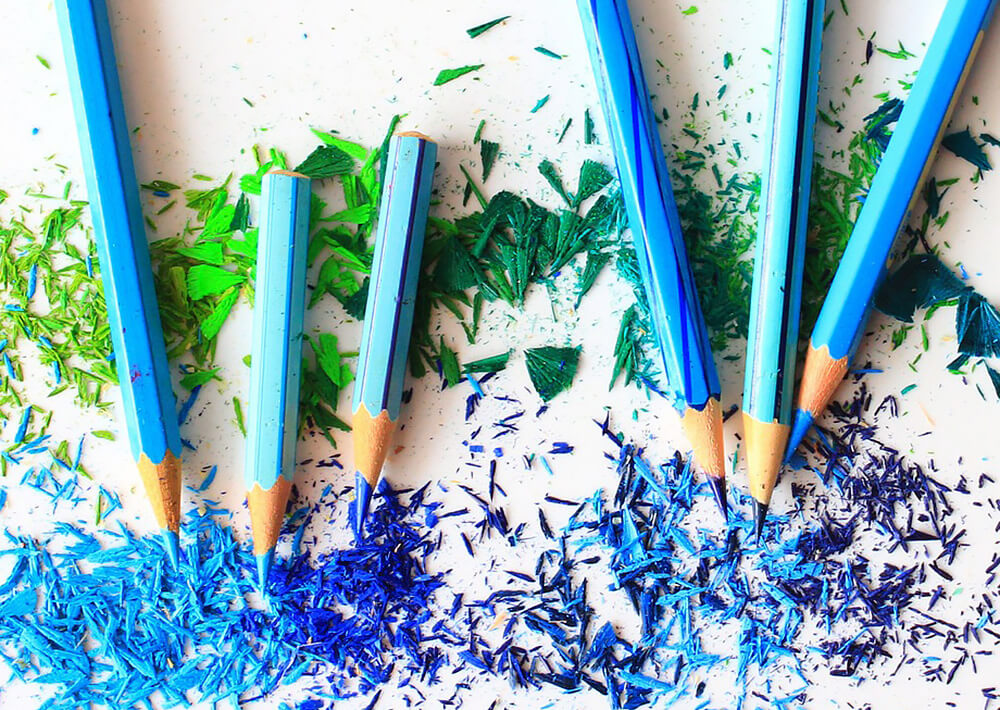I have been involved with art ever since I was a child and studied fine art in college. For years I worked mostly in pen and ink, but about one and a half years ago I discovered coloured pencil—and I love them.
I am by no means an expert but would like to share some of the useful coloured pencil tips I have learned so far, in case they help anyone else.
Drawing tips for beginner coloured pencil artists
1. Use scrap paper or glassine to prevent smudging
Placing a piece of scrap paper under your hand as you draw will keep you from resting it against your drawing and potentially smudging your work. (I realise many of you will already know this, but I am sharing it for the absolute beginner to art.)
2. Save good paper as scrap
I have a folder for good paper that is now scrap—I can test colours on them by layering, using blenders, etc, which allows me to see how the colours will look on the same (good) paper that I’m using for my drawing.
3. Use a light hand when layering
I started out with a very heavy hand and found that I lost the tooth of the paper very quickly and could no longer add colours. If you start off lightly, you’ll be able to add more color later.
Also the paper that I was using was not the best. . . Now I work with Strathmore Bristol Smooth 300 series, Clairfontaine Pastel Mat and Pastel Mat Board, Art Spectrum Colourfix Smooth to name a few of my favourite surfaces.
4. Work from light to dark
I prefer to work from light to dark so that my colours blend easily and don’t get a muddied look. Of course there is always an exception to the rule—on Pastel Mat, for example, you may want to work from dark to light.
(However, I generally work light to dark even on Pastel Mat.)
5. Blend with a white pencil or OMS
To get pencils to blend and look more painterly you can go over them with:
• A blending pencil
• A white pencil (Prismacolor Premier white is very good)
• A lighter colour (ie light pink to blend over darker pinks and purples)
• A tortillon
• Odourless Mineral Spirits such as Zest-it or Gamsol
On the whole I prefer blending with a white pencil or lighter-coloured pencil and using very hard pressure. You can then re-add colour with your darker pencils.
6. Push past the “ugly duckling” stage
I dislike calling art ugly but there is a definitely a stage where I feel discouraged and that my work is awful. I have found that I just need to keep adding layers of colour. . . eventually the drawing will emerge and I will feel relieved and excited to continue.
7. Use fixative for extra tooth (if needed)
Sometimes even with a light hand paper can lose tooth. Luckily, there are workable fixatives one can use to restore tooth to the paper. Brush and Pencil also has a powder that can add tooth.
8. PanPastel makes a great underpainting
One way to save time is by putting a layer or two of PanPastel down on your drawing before starting with coloured pencils. You can also use them to mark out light and dark areas.
9. Learn from the best
I have learned valuable lessons from many artists online. Here are a few places and artists I recommend:
Bluprint (formerly Craftsy.com)
Karen Hull
Cynthia Knox
Ann Kullberg
10. Make use of copyright-free resources
It’s always easier to draw from a reference photo than from your imagination. Most of the following sites offer photographs under the creative commons license, which means they are free to use for personal and commercial work. (Remember to always credit the photographer or site.)
Pixabay
Flickr (set to all creative commons)
Morguefile
Photos4artists.co.uk (click on go to free galleries)
Unsplash
There are also many Facebook groups for free photo references—just search for groups like “Photos for Artists” or “Free Artist Reference Photos” in Facebook.
I hope you’ve discovered something you can use today!
Special thanks to Robin Rudolph for sharing her coloured pencil tips. To learn more about Robin or see her art, please visit her Instagram page
This post may contain affiliate links.

